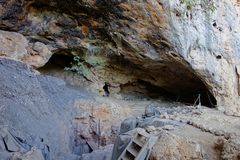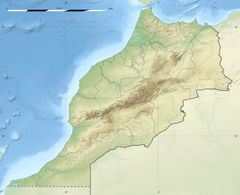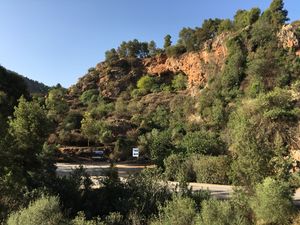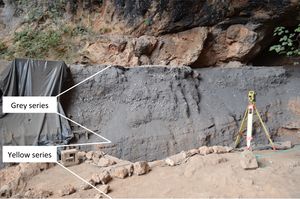تافوغالت
تافوغالت | |
 الكهف في سبتمبر 2017 | |
| الاسم البديل | مغارة الحمَام |
|---|---|
| المكان | بالقرب من قرية تافوغالت، شمال وجدة |
| المنطقة | المغرب |
| الإحداثيات | 34°48′38″N 2°24′30″W / 34.81056°N 2.40833°W |
| التاريخ | |
| الفترات | الپاليوليثي الأوسط, Epipalaeolithic |
| الثقافات | pre-Mousterian, العاترية، أيبيروموروسية |
| ملاحظات حول الموقع | |
| تواريخ الحفريات | 1944–1947, 1950–1955, 1969-1977, 2003-2018 (ongoing) |
| الاتاحة للعامة | No |
تافوغالت Taforalt أو مغارة الحمَام Grotte des Pigeons في شمال وجدة بالمغرب الشرقي، على بعد حوالي 55 كلم شمال غرب وجدة. انطلقت الحفريات الأثرية بهذا الموقع منذ سنة 1951 من طرف مجموعة من الباحثين الأجانب وذلك بتعاون مع المغرب، وقد أسفرت عن مجموعة من النتائج المهمة وأثبتت تعاقب مجموعة من الحضارات على الموقع وذلك منذ العصر الحجري القديم الأوسط. وتبقى أهم حضارة يعرف بها موقع تافوغالت هي الثقافة " أيبيروموروسية" والتي أثبتت نتائج التأريخ تواجدها بالموقع بين 21.900 و 10.800 قبل الفترة الحالية. يتميز هذا الموقع بأهمية اللقى الأثرية والمتمثلة في مجموعة من الهياكل العظمية والأدوات الحجرية والعظمية وكذلك الحلي وبقايا عظام الحيوانات.
الجغرافيا
التطابق
الدنا العتيق
In 2018, van de Loosdrecht et al. performed the first aDNA tests on the ancient Taforalt individuals, directly dated to between 15,100 and 13,900 cal BP.[1] The Taforalt samples are the oldest human DNA samples from Africa yet recovered.[2] DNA analysis was performed on seven individuals: six males and one female. Only five of individuals, including four of the males, with higher coverage genomes were used in the nuclear DNA analysis. Nuclear DNA analysis reveals that the Taforalt individuals were all closely related to each other, showing evidence of a population bottleneck event in their past."[1]
The Taforalt genomes were found to be composed of three major components: a Holocene Levantine component, a Hadza hunter-gatherer component from Tanzania, and a West African component. The Taforalt individuals show closest genetic affinity for ancient Epipaleolithic Natufian individuals, with slightly better affinity for the Natufians than later Neolithic Levantines. A two-way admixture scenario using Natufian and modern West African samples as reference populations inferred that the Taforalt individuals bore 63.5% Natufian-related and 36.5% West African-related ancestries, with no evidence for additional gene flow from the Epigravettian culture of Upper Paleolithic Europe. The Taforalt individuals also show evidence of limited Neanderthal ancestry.[1]
When compared against modern populations, the Taforalt individuals form a distinct cluster and do not cluster genetically with any modern population; however, they were found to cluster between modern North Africans and East Africans. The Taforalt individuals also exhibit higher levels of Sub-Saharan and Hadza-related ancestry than do modern North Africans.[1]
| Sample ID | mtDNA | Y-DNA |
|---|---|---|
| TAF009 | U6a6b | E1b1b1a1b1 |
| TAF010 | U6a7b | E1b1b1a1 |
| TAF011 | U6a7 | E1b1b1a1 |
| TAF012 | U6a7 | N/A |
| TAF013 | U6a7b | E1b1b1a1 |
| TAF014 | M1b | E1b1b1a1 |
| TAF015 | U6a1b | E1b1b |
mtDNA analysis shows that the Taforalt individuals belonged to mtDNA haplogroups U6a and M1b. Y-DNA analysis shows that the Taforalt males all belonged to Y-DNA haplogroup E1b1b1a1 (M78), which is closely related to the E1b1b1b (M123) subhaplogroup that has been observed in skeletal remains belonging to the Epipaleolithic Natufian and Pre-Pottery Neolithic cultures of the Levant.[1]
Since the Natufian samples, which are chronologically younger than the Taforalt samples by several thousands of years, were inferred to lack substantial African ancestry, the researchers also hypothesized that a Maghreb center of evolution for the Natufian-related ancestry could only be plausible if the admixture that was inferred for the Taforalt individuals either occurred after the population ancestral to the Natufians had moved into the Levant or if that admixture event was a locally-confined phenomenon at Taforalt.[1]
Phenotypic analysis was performed on four of the Taforalt individuals with higher genomic coverage. The Taforalt individuals tested did not carry either of the derived SLC24A5 alleles associated with lighter skin color, the derived OCA2 allele associated with blue eye color, or the derived MCM6 allele associated with lactase persistence. However, they were found to carry the ancestral SLC24A4 allele associated with dark eye color.[1]
انظر أيضاً
المراجع
- ^ أ ب ت ث ج ح خ van de Loosdrecht; et al. (2018-03-15). "Pleistocene North African genomes link Near Eastern and sub-Saharan African human populations". Science. 360 (6388): 548–552. doi:10.1126/science.aar8380. ISSN 0036-8075. PMID 29545507.
- ^ Embury-Dennis, Tom (2018-03-28). "Scientists uncover ancient migration clues after studying oldest DNA ever from Africa". The Independent. Retrieved 2018-05-17.


